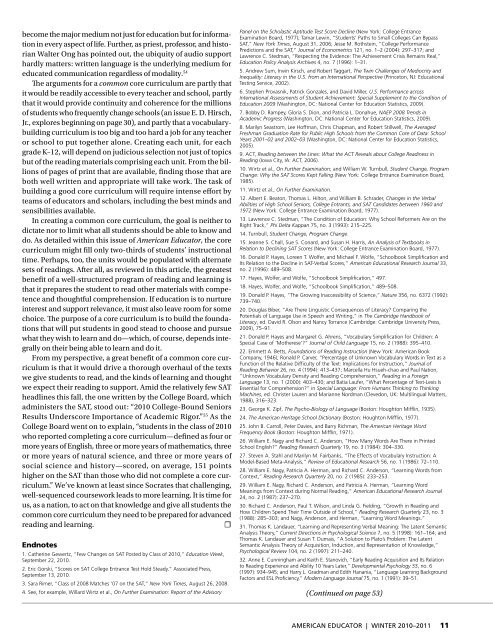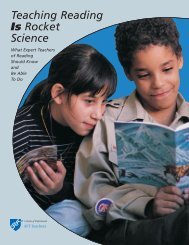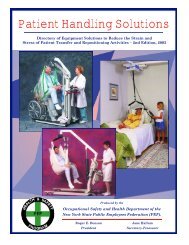American Educator, Winter 2010-11, Vol. 34, No. 4, AFT
American Educator, Winter 2010-11, Vol. 34, No. 4, AFT
American Educator, Winter 2010-11, Vol. 34, No. 4, AFT
Create successful ePaper yourself
Turn your PDF publications into a flip-book with our unique Google optimized e-Paper software.
ecome the major medium not just for education but for information<br />
in every aspect of life. Further, as priest, professor, and historian<br />
Walter Ong has pointed out, the ubiquity of audio support<br />
hardly matters: written language is the underlying medium for<br />
educated communication regardless of modality. 54<br />
The arguments for a common core curriculum are partly that<br />
it would be readily accessible to every teacher and school, partly<br />
that it would provide continuity and coherence for the millions<br />
of students who frequently change schools (an issue E. D. Hirsch,<br />
Jr., explores beginning on page 30), and partly that a vocabularybuilding<br />
curriculum is too big and too hard a job for any teacher<br />
or school to put together alone. Creating each unit, for each<br />
grade K–12, will depend on judicious selection not just of topics<br />
but of the reading materials comprising each unit. From the billions<br />
of pages of print that are available, finding those that are<br />
both well written and appropriate will take work. The task of<br />
building a good core curriculum will require intense effort by<br />
teams of educators and scholars, including the best minds and<br />
sensibilities available.<br />
In creating a common core curriculum, the goal is neither to<br />
dictate nor to limit what all students should be able to know and<br />
do. As detailed within this issue of <strong>American</strong> <strong>Educator</strong>, the core<br />
curriculum might fill only two-thirds of students’ instructional<br />
time. Perhaps, too, the units would be populated with alternate<br />
sets of readings. After all, as reviewed in this article, the greatest<br />
benefit of a well-structured program of reading and learning is<br />
that it prepares the student to read other materials with competence<br />
and thoughtful comprehension. If education is to nurture<br />
interest and support relevance, it must also leave room for some<br />
choice. The purpose of a core curriculum is to build the foundations<br />
that will put students in good stead to choose and pursue<br />
what they wish to learn and do—which, of course, depends integrally<br />
on their being able to learn and do it.<br />
From my perspective, a great benefit of a common core curriculum<br />
is that it would drive a thorough overhaul of the texts<br />
we give students to read, and the kinds of learning and thought<br />
we expect their reading to support. Amid the relatively few SAT<br />
headlines this fall, the one written by the College Board, which<br />
administers the SAT, stood out: “<strong>2010</strong> College-Bound Seniors<br />
Results Underscore Importance of Academic Rigor.” 55 As the<br />
College Board went on to explain, “students in the class of <strong>2010</strong><br />
who reported completing a core curriculum—defined as four or<br />
more years of English, three or more years of mathematics, three<br />
or more years of natural science, and three or more years of<br />
social science and history—scored, on average, 151 points<br />
higher on the SAT than those who did not complete a core curriculum.”<br />
We’ve known at least since Socrates that challenging,<br />
well-sequenced coursework leads to more learning. It is time for<br />
us, as a nation, to act on that knowledge and give all students the<br />
common core curriculum they need to be prepared for advanced<br />
reading and learning. ☐<br />
Endnotes<br />
1. Catherine Gewertz, “Few Changes on SAT Posted by Class of <strong>2010</strong>,” Education Week,<br />
September 22, <strong>2010</strong>.<br />
2. Eric Gorski, “Scores on SAT College Entrance Test Hold Steady,” Associated Press,<br />
September 13, <strong>2010</strong>.<br />
3. Sara Rimer, “Class of 2008 Matches ’07 on the SAT,” New York Times, August 26, 2008.<br />
4. See, for example, Willard Wirtz et al., On Further Examination: Report of the Advisory<br />
Panel on the Scholastic Aptitude Test Score Decline (New York: College Entrance<br />
Examination Board, 1977); Tamar Lewin, “Students’ Paths to Small Colleges Can Bypass<br />
SAT,” New York Times, August 31, 2006; Jesse M. Rothstein, “College Performance<br />
Predictions and the SAT,” Journal of Econometrics 121, no. 1–2 (2004): 297–317; and<br />
Lawrence C. Stedman, “Respecting the Evidence: The Achievement Crisis Remains Real,”<br />
Education Policy Analysis Archives 4, no. 7 (1996): 1–31.<br />
5. Andrew Sum, Irwin Kirsch, and Robert Taggart, The Twin Challenges of Mediocrity and<br />
Inequality: Literacy in the U.S. from an International Perspective (Princeton, NJ: Educational<br />
Testing Service, 2002).<br />
6. Stephen Provasnik, Patrick Gonzales, and David Miller, U.S. Performance across<br />
International Assessments of Student Achievement: Special Supplement to the Condition of<br />
Education 2009 (Washington, DC: National Center for Education Statistics, 2009).<br />
7. Bobby D. Rampey, Gloria S. Dion, and Patricia L. Donahue, NAEP 2008 Trends in<br />
Academic Progress (Washington, DC: National Center for Education Statistics, 2009).<br />
8. Marilyn Seastrom, Lee Hoffman, Chris Chapman, and Robert Stillwell, The Averaged<br />
Freshman Graduation Rate for Public High Schools from the Common Core of Data: School<br />
Years 2001–02 and 2002–03 (Washington, DC: National Center for Education Statistics,<br />
2005).<br />
9. ACT, Reading between the Lines: What the ACT Reveals about College Readiness in<br />
Reading (Iowa City, IA: ACT, 2006).<br />
10. Wirtz et al., On Further Examination; and William W. Turnbull, Student Change, Program<br />
Change: Why the SAT Scores Kept Falling (New York: College Entrance Examination Board,<br />
1985).<br />
<strong>11</strong>. Wirtz et al., On Further Examination.<br />
12. Albert E. Beaton, Thomas L. Hilton, and William B. Schrader, Changes in the Verbal<br />
Abilities of High School Seniors, College Entrants, and SAT Candidates between 1960 and<br />
1972 (New York: College Entrance Examination Board, 1977).<br />
13. Lawrence C. Stedman, “The Condition of Education: Why School Reformers Are on the<br />
Right Track,” Phi Delta Kappan 75, no. 3 (1993): 215–225.<br />
14. Turnbull, Student Change, Program Change.<br />
15. Jeanne S. Chall, Sue S. Conard, and Susan H. Harris, An Analysis of Textbooks in<br />
Relation to Declining SAT Scores (New York: College Entrance Examination Board, 1977).<br />
16. Donald P. Hayes, Loreen T. Wolfer, and Michael F. Wolfe, “Schoolbook Simplification and<br />
Its Relation to the Decline in SAT-Verbal Scores,” <strong>American</strong> Educational Research Journal 33,<br />
no. 2 (1996): 489–508.<br />
17. Hayes, Wolfer, and Wolfe, “Schoolbook Simplification,” 497.<br />
18. Hayes, Wolfer, and Wolfe, “Schoolbook Simplification,” 489–508.<br />
19. Donald P. Hayes, “The Growing Inaccessibility of Science,” Nature 356, no. 6372 (1992):<br />
739–740.<br />
20. Douglas Biber, “Are There Linguistic Consequences of Literacy? Comparing the<br />
Potentials of Language Use in Speech and Writing,” in The Cambridge Handbook of<br />
Literacy, ed. David R. Olson and Nancy Torrance (Cambridge: Cambridge University Press,<br />
2009), 75–91.<br />
21. Donald P. Hayes and Margaret G. Ahrens, “Vocabulary Simplification for Children: A<br />
Special Case of ‘Motherese’?” Journal of Child Language 15, no. 2 (1988): 395–410.<br />
22. Emmett A. Betts, Foundations of Reading Instruction (New York: <strong>American</strong> Book<br />
Company, 1946); Ronald P. Carver, “Percentage of Unknown Vocabulary Words in Text as a<br />
Function of the Relative Difficulty of the Text: Implications for Instruction,” Journal of<br />
Reading Behavior 26, no. 4 (1994): 413–437; Marcella Hu Hsueh-chao and Paul Nation,<br />
“Unknown Vocabulary Density and Reading Comprehension,” Reading in a Foreign<br />
Language 13, no. 1 (2000): 403–430; and Batia Laufer, “What Percentage of Text-Lexis Is<br />
Essential for Comprehension?” in Special Language: From Humans Thinking to Thinking<br />
Machines, ed. Christer Lauren and Marianne <strong>No</strong>rdman (Clevedon, UK: Multilingual Matters,<br />
1988), 316–323.<br />
23. George K. Zipf, The Psycho-Biology of Language (Boston: Houghton Mifflin, 1935).<br />
24. The <strong>American</strong> Heritage School Dictionary (Boston: Houghton Mifflin, 1977).<br />
25. John B. Carroll, Peter Davies, and Barry Richman, The <strong>American</strong> Heritage Word<br />
Frequency Book (Boston: Houghton Mifflin, 1971).<br />
26. William E. Nagy and Richard C. Anderson, “How Many Words Are There in Printed<br />
School English?” Reading Research Quarterly 19, no. 3 (1984): 304–330.<br />
27. Steven A. Stahl and Marilyn M. Fairbanks, “The Effects of Vocabulary Instruction: A<br />
Model-Based Meta-Analysis,” Review of Educational Research 56, no. 1 (1986): 72–<strong>11</strong>0.<br />
28. William E. Nagy, Patricia A. Herman, and Richard C. Anderson, “Learning Words from<br />
Context,” Reading Research Quarterly 20, no. 2 (1985): 233–253.<br />
29. William E. Nagy, Richard C. Anderson, and Patricia A. Herman, “Learning Word<br />
Meanings from Context during <strong>No</strong>rmal Reading,” <strong>American</strong> Educational Research Journal<br />
24, no. 2 (1987): 237–270.<br />
30. Richard C. Anderson, Paul T. Wilson, and Linda G. Fielding, “Growth in Reading and<br />
How Children Spend Their Time Outside of School,” Reading Research Quarterly 23, no. 3<br />
(1988): 285–303; and Nagy, Anderson, and Herman, “Learning Word Meanings.”<br />
31. Thomas K. Landauer, “Learning and Representing Verbal Meaning: The Latent Semantic<br />
Analysis Theory,” Current Directions in Psychological Science 7, no. 5 (1998): 161–164; and<br />
Thomas K. Landauer and Susan T. Dumais, “A Solution to Plato’s Problem: The Latent<br />
Semantic Analysis Theory of Acquisition, Induction, and Representation of Knowledge,”<br />
Psychological Review 104, no. 2 (1997): 2<strong>11</strong>–240.<br />
32. Anne E. Cunningham and Keith E. Stanovich, “Early Reading Acquisition and Its Relation<br />
to Reading Experience and Ability 10 Years Later,” Developmental Psychology 33, no. 6<br />
(1997): 9<strong>34</strong>–945; and Harry L. Gradman and Edith Hanania, “Language Learning Background<br />
Factors and ESL Proficiency,” Modern Language Journal 75, no. 1 (1991): 39–51.<br />
(Continued on page 53)<br />
AMERICAN EDUCATOR | WINTER <strong>2010</strong>–20<strong>11</strong> <strong>11</strong>





